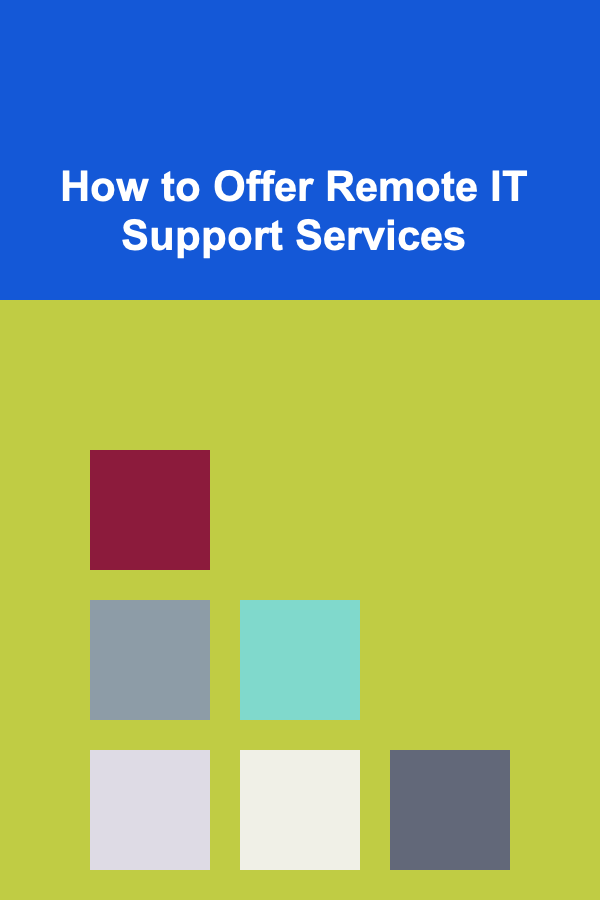
How to Offer Remote IT Support Services
ebook include PDF & Audio bundle (Micro Guide)
$12.99$7.99
Limited Time Offer! Order within the next:

In the modern business landscape, technology is more crucial than ever. From cloud computing to network infrastructure, every organization relies on IT systems to function efficiently. However, these systems often require ongoing maintenance, troubleshooting, and technical support to ensure their optimal performance. This is where remote IT support services come into play.
Remote IT support services are becoming an increasingly popular solution for businesses and individuals, as they provide an efficient, cost-effective, and scalable way to manage IT problems without the need for on-site intervention. In this article, we will explore how to offer remote IT support services, including the steps involved, the necessary tools, and best practices to provide exceptional service to your clients.
The Rise of Remote IT Support
Remote IT support has gained significant traction in recent years due to several factors:
- Advancements in Technology: The development of faster internet speeds, cloud computing, and remote access software has made it easier than ever to provide IT support from a distance.
- Globalization: As businesses become increasingly global, the need for IT support that can be accessed from anywhere in the world has surged.
- Cost Efficiency: Remote IT support eliminates the need for on-site visits, which can be time-consuming and costly. It allows businesses to save on travel expenses and staff downtime.
- Flexibility: Remote IT support enables technicians to work from anywhere, offering flexibility to both the service provider and the client.
These benefits have led to a surge in demand for remote IT support services across various industries, making it an attractive business opportunity.
Key Steps to Offering Remote IT Support
To successfully offer remote IT support services, there are several essential steps that you need to take, from setting up the necessary infrastructure to building a client base. Below, we break down the critical components involved in launching your remote IT support business.
1. Define Your Niche and Target Audience
The first step in offering remote IT support is to define your niche and target audience. IT support services are vast, ranging from basic troubleshooting to advanced network management. By focusing on a specific area, you can position yourself as an expert and attract the right clients.
Some niches to consider within remote IT support include:
- Home Users: Providing technical support for individuals with software, hardware, or network-related issues.
- Small Businesses: Offering cost-effective IT solutions for small and medium-sized businesses that may not have a dedicated IT department.
- Enterprise Support: Providing more advanced IT support to larger organizations, including server maintenance, network monitoring, and data security.
- Software Support: Assisting clients with specific software applications, such as troubleshooting, installations, and updates.
- Cloud Services: Offering support for cloud-based platforms like Google Workspace, Microsoft 365, or AWS.
2. Set Up the Necessary Infrastructure
To offer remote IT support, you need to establish the appropriate technical infrastructure to communicate with clients and resolve their issues effectively. Here are the key tools and resources you'll need:
Remote Access Software
Remote access software is essential for providing IT support services. It allows you to connect to your client's systems remotely and troubleshoot issues. Some popular remote access tools include:
- TeamViewer: One of the most widely used remote access tools, offering easy-to-use features and robust security.
- AnyDesk: A lightweight and fast remote access solution, often used for IT support and troubleshooting.
- LogMeIn: A remote support tool designed for businesses that need secure, remote access to multiple devices.
- RemotePC: A budget-friendly option that provides remote access and support, particularly suited for small businesses.
These tools allow you to take control of the client's system, perform diagnostic tests, and make necessary fixes, all from a remote location.
Ticketing System
A ticketing system is an essential tool for managing support requests and ensuring efficient workflow. It helps you keep track of issues, monitor progress, and respond to clients in an organized manner. Popular ticketing systems include:
- Zendesk
- Freshdesk
- Jira Service Management
These platforms can help streamline communication, track client interactions, and automate certain aspects of the support process, ensuring that no issue is overlooked.
Communication Tools
Clear and effective communication is crucial for remote IT support. In addition to the remote access tools, you will need reliable communication channels to interact with clients. This can include:
- VoIP Systems: For making phone calls over the internet. Popular options include Zoom, Skype, and Google Voice.
- Live Chat: Offering immediate assistance through chat platforms, such as Intercom or Drift.
- Email: To send detailed solutions, follow-up information, and support documentation.
3. Get Certified and Stay Updated
To offer high-quality IT support, it's essential to have the proper certifications and stay up-to-date with the latest technologies and trends in IT. Some certifications that can help boost your credibility and expertise in the field include:
- CompTIA A+: A foundational certification for IT technicians covering hardware, software, and networking.
- Microsoft Certified Solutions Associate (MCSA): A certification focusing on Microsoft technologies, such as Windows Server and Office 365.
- Cisco Certified Network Associate (CCNA): A certification focusing on networking, ideal for technicians specializing in network support.
- Certified Information Systems Security Professional (CISSP): A certification for IT professionals focusing on cybersecurity.
Regularly attending training and certification programs ensures that you are up-to-date with the latest tools, security practices, and troubleshooting techniques.
4. Develop a Pricing Model
One of the most important aspects of running a remote IT support business is establishing a clear and competitive pricing model. There are several pricing models you can choose from:
- Hourly Rate: Charging clients based on the time spent resolving their issues. This is a common pricing model for general IT support.
- Flat Fee: Offering a fixed price for a specific service or project, such as setting up a network or resolving a particular issue.
- Subscription Model: Charging clients a monthly or annual fee for ongoing support. This model is often used for businesses that require continuous IT support.
- Pay-as-You-Go: Clients pay only for the support they need, making this model suitable for occasional or one-off issues.
Consider your target market and competition when setting your prices. Be transparent about your fees, and offer different pricing tiers or packages to accommodate various client needs.
5. Market Your Remote IT Support Services
Once you have set up your infrastructure and defined your service offerings, it's time to market your remote IT support business. Effective marketing will help you attract clients and build a reputation in your niche. Some strategies to consider include:
Online Presence
A strong online presence is critical for attracting clients. This includes:
- Website: A professional website that outlines your services, certifications, and contact information. You can also include a blog to share useful IT tips and updates.
- Social Media: Use platforms like LinkedIn, Facebook, and Twitter to engage with potential clients, share success stories, and promote your services.
- SEO: Optimize your website for search engines so that potential clients can easily find your business when searching for IT support services.
Networking and Referrals
Word-of-mouth referrals are one of the most powerful marketing tools in the IT support industry. Encourage satisfied clients to refer your services to others by offering incentives, such as discounts or free consultations.
You can also network with local businesses, industry professionals, and online communities to establish connections and gain more exposure.
Paid Advertising
Consider using paid advertising options, such as Google Ads or Facebook Ads, to reach a wider audience. This is especially useful for targeting specific geographic areas or niche markets.
6. Provide Excellent Customer Support
Offering remote IT support is not just about solving technical issues; it's about providing an excellent customer experience. Here are some best practices for delivering exceptional service:
- Clear Communication: Always communicate with clarity and patience. IT issues can be confusing for clients, so it's important to explain solutions in simple terms.
- Timeliness: Ensure that you respond to support requests promptly and resolve issues as quickly as possible.
- Follow-Up: After resolving an issue, follow up with clients to ensure they are satisfied with the solution and offer further assistance if needed.
- Continuous Learning: Stay updated with the latest technology and troubleshooting techniques to improve your services.
Conclusion
Offering remote IT support services can be a rewarding business opportunity that provides clients with the technical expertise they need, without the high costs and logistics associated with on-site visits. By defining your niche, setting up the right infrastructure, obtaining certifications, developing a solid pricing model, and marketing your services effectively, you can build a successful remote IT support business. Remember that the key to success is not just resolving issues but also providing excellent customer service and continuous support. With the right approach, you can grow your client base, improve your technical skills, and establish yourself as a trusted IT support provider in your industry.
Reading More From Our Other Websites
- [Organization Tip 101] How to Utilize Drawer Organizers for Craft Tools
- [Personal Investment 101] How to Make Money with AI: Using Deep Learning to Create Products
- [Small Business 101] Why a Business Line of Credit is Crucial for New Business Growth
- [Gardening 101] 10 Stunning Garden Walkway Designs to Transform Your Outdoor Space
- [Organization Tip 101] Top Tips for Installing Herringbone Tiles in Your Kitchen
- [Organization Tip 101] How to Use Over-the-Door Organizers Effectively
- [Personal Financial Planning 101] How to Create a Personal Financial Statement Template for Clarity
- [Organization Tip 101] How to Create a Legacy through Your Time Capsule
- [Home Storage Solution 101] How to Maximize Storage in Your Bathroom with Over-the-Door Organizers
- [Home Family Activity 101] How to Organize a Family Puzzle Night for Everyone to Enjoy

How to Create a Family Craft Night Tradition
Read More
How to Make Money Online as a Logo Designer: 10 Actionable Ideas
Read More
How To Master Behavioral Marketing
Read More
How to Set Financial Goals and Achieve Them
Read More
How to Use Dollar-Cost Averaging in Cryptocurrency Investments
Read More
Developing Early Reasoning and Logic Through Games
Read MoreOther Products

How to Create a Family Craft Night Tradition
Read More
How to Make Money Online as a Logo Designer: 10 Actionable Ideas
Read More
How To Master Behavioral Marketing
Read More
How to Set Financial Goals and Achieve Them
Read More
How to Use Dollar-Cost Averaging in Cryptocurrency Investments
Read More